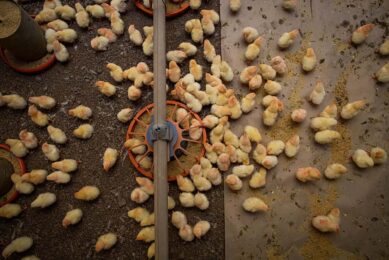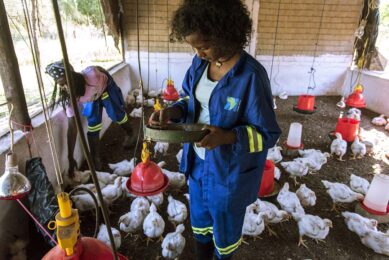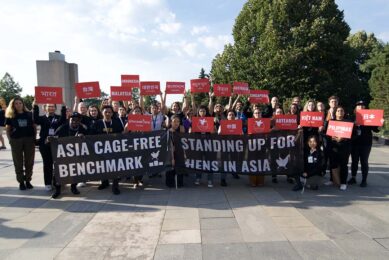‘Different mindset needed for antibiotic use in animal husbandry’

A new antimicrobial resistance mechanism has been found in bacteria from Chinese pigs, pork, poultry meat and humans. This is a serious public health threat because it results in resistance to what is considered to be a last resort antibiotic in human medicine. Prof Dik Mevius of the Dutch Central Veterinary Institute explains the consequences.
What exactly is the situation in China?
“Colistin is a class of antibiotics that has been used in animals for treatment and control of diarrhoea for decades. It has become important in human medicine due to the fast evolution of resistance over the past decade. The rapid spread of ESBL- and carbapenemase-producing organisms – has made colistin a last resort antibiotic for humans infected with multi-drug resistant bacteria. The finding in China is therefore primarily a human problem.
Since the 50s, colistin is used on a large scale in livestock, especially to treat and control diarrhoea caused by Escherichia coli and Salmonella infections in young cattle and pigs. In the poultry sector colistin is used in the treatment of colibacillosis in laying hens as there is no withdrawal period set for eggs. Colistin is a so called polymyxin. The use of polymyxins has dramatically decreased during the past years. Recently Chinese and British scientists reported that they have found a strain of Escherichia coli which is resistant to colistin. In China – and there are indications this also applies to other parts of South East Asia – a transmittable form of resistance has been discovered in pigs, pork and poultry meat, and also in a small number of Chinese people.
A direct link has been established between the use of the antibiotic in animal husbandry and the resistance found in slaughtered animals, in food and in humans. This resistance, caused by a new mutation dubbed the MCR-1 gene, is also capable of spreading. The samples of the study were taken from pork and poultry meat from supermarkets and wet markets. Additionally samples were taken from hospitalised people. About 20% of the animals and 15% of the meat carried resistant bacteria. The resistance is quite worrying as bacteria can exchange the resistance amongst each other and also in between species. Although there is no proof of a causal connection, it is considered likely the animal industry is the source of the problem. In China antibiotics are applied on a large scale, animal husbandry is booming.”
What is the extent of the threat?
“This undesirable development exerts more pressure on health care. Particularly in combination with the ESBL problems which exist on a global scale. We must be alert, not because colistin resistance is an enormous problem in animal husbandry. But we don’t want the livestock industry to become a reservoir of resistant bacteria, with a potential risk for public health. Resistant bacteria can spread on an epidemic scale in a short period of time. The worst case scenario would be that there is no treatment left for humans with infections. This can lead us back to the pre-antibiotics era. The future does not look bright then, with possible tens or hundreds of thousands of deaths caused by outbreaks and antibiotic resistance.”
How fast do you expect this problem to spread?
“That is rather unpredictable. The world is small and globalisation involves a constant exchange of humans and materials. Products, and this certainly applies to the poultry sector, originate from all corners of the world. Problems like this do not remain restricted to a specific area, but have to potential of soon becoming a global issue. Humans can be a source, as can materials, and even wild birds. We now know what to look for. This provides us with tools to recognise the resistance when it occurs. When the production chain spreads the bacteria the situation might get out of hand.”
Prof Dr Dik Mevius: “We must be alert, not because colistin resistance is an enormous problem in animal husbandry. But we don’t want the livestock industry to become a reservoir of resistant bacteria, with a potential risk for public health.”
How should this situation be handled on a global scale?
“This subject has received massive world attention. There have been previous calls for curtailing the use of polymyxins in agriculture. We must all reiterate these appeals and take them to the highest levels of government. A crucial aspect is the colistin use in a country. We must think the situation through. Will we advise to forbid the use of colistin in livestock? Or only when there is proof there is no alternative for it? Governments, sector organisations and veterinarian organisations must address this issue. A local approach is most effective approach. The subject is currently on all agendas. The implications of the current developments are also being discussed on a European and global level – this is a very slow process as global and European organisations are less powerful. It is however in everyone’s benefit to place this topic high on every agenda.
In 2012, the World Health Organization Advisory Group on Integrated Surveillance of Antimicrobial Resistance described colistin as an antibiotic of critical importance. This also counts for animals, poultry for instance. Implementing measures which involve enormous reductions will be extremely challenging. Still, this is a challenge countries are facing. The use of colistin must be reduced. The influence of the West on Asia is only limited. However, it is important politics and scientists join forces and take action. For Asia this implies being aware of the negative effects of their booming industrial developments and realising the choices they make effect people. This is complicated when it concerns antibiotics. Use of colistin in the pig and poultry sector has a significant impact on the industry.”
What will have to change in the poultry sector?
“To secure public health on a global scale a transition will have to be made towards a completely different husbandry system, which will not induce this type of resistance. In the poultry industry, but also in other livestock industries, a different mindset is needed. We must focus on animal health instead of production at a low cost price. We must concentrate on preventing health issues instead of systematically clamping down infections. At world level this is currently only a drop in the ocean. What we need is to obtain a hearing on a larger scale.”
Dik Mevius
Prof Dr Dik Mevius is senior researcher at Central Veterinary Institute, Lelystad, the Netherlands. At the CVI Mevius is responsible for the Dutch national reference laboratory on antimicrobial resistance in animals. He also holds a chair at Utrecht University and has participated and still has a role in many policy advisory boards and committees on national and European level, such as the Expert Panel Veterinary Medicines Authority and the Veterinary Antibiotics Usage and Resistance Surveillance work group.
Join 31,000+ subscribers
Subscribe to our newsletter to stay updated about all the need-to-know content in the poultry sector, three times a week. Beheer
Beheer








 WP Admin
WP Admin  Bewerk bericht
Bewerk bericht